key Alfa Romeo Giulietta 2012 Owner handbook (in English)
[x] Cancel search | Manufacturer: ALFA ROMEO, Model Year: 2012, Model line: Giulietta, Model: Alfa Romeo Giulietta 2012Pages: 297, PDF Size: 9.37 MB
Page 81 of 297
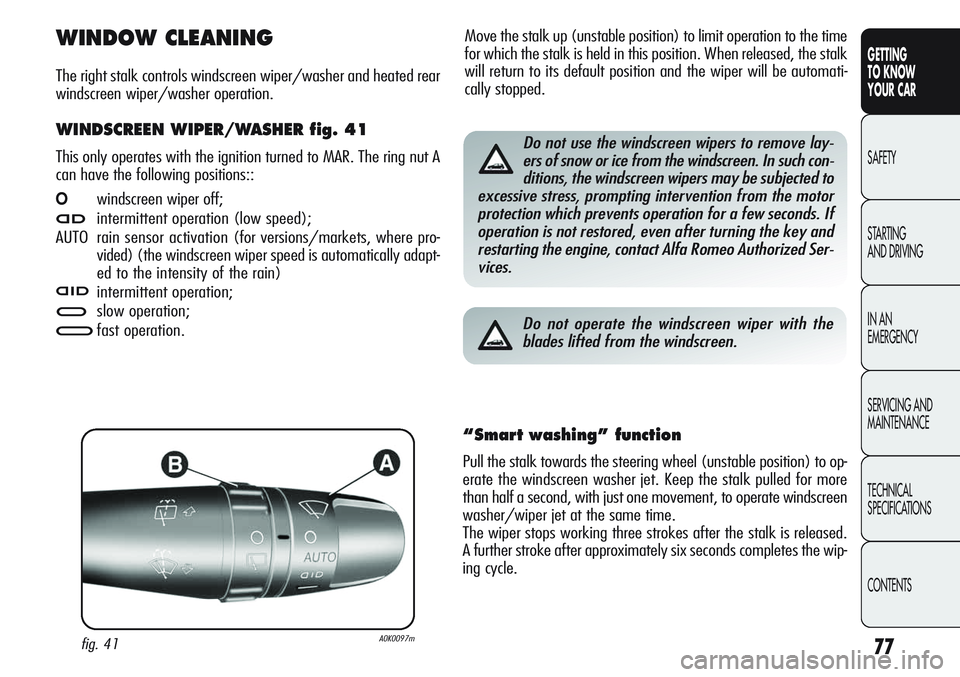
77
GETTING
TO KNOW
YOUR CAR
SAFETY
STARTING
AND DRIVING
IN AN
EMERGENCY
SERVICING AND
MAINTENANCE
TECHNICAL
SPECIFICATIONS
CONTENTS
Move the stalk up (unstable position) to limit operation to the time
for which the stalk is held in this position. When released, the stalk
will return to its default position and the wiper will be automati-
cally stopped.WINDOW CLEANING
The right stalk controls windscreen wiper/washer and heated rear
windscreen wiper/washer operation.
WINDSCREEN WIPER/WASHER fig. 41
This only operates with the ignition turned to MAR. The ring nut A
can have the following positions::
Owindscreen wiper off;
≤intermittent operation (low speed);
AUTO rain sensor activation (for versions/markets, where pro-
vided) (the windscreen wiper speed is automatically adapt-
ed to the intensity of the rain)
nintermittent operation;
≥slow operation;
¥fast operation.
fig. 41A0K0097m
Do not use the windscreen wipers to remove lay-
ers of snow or ice from the windscreen. In such con-
ditions, the windscreen wipers may be subjected to
excessive stress, prompting intervention from the motor
protection which prevents operation for a few seconds. If
operation is not restored, even after turning the key and
restarting the engine, contact Alfa Romeo Authorized Ser-
vices.
Do not operate the windscreen wiper with the
blades lifted from the windscreen.
“Smart washing” function
Pull the stalk towards the steering wheel (unstable position) to op-
erate the windscreen washer jet. Keep the stalk pulled for more
than half a second, with just one movement, to operate windscreen
washer/wiper jet at the same time.
The wiper stops working three strokes after the stalk is released.
A further stroke after approximately six seconds completes the wip-
ing cycle.
Page 86 of 297
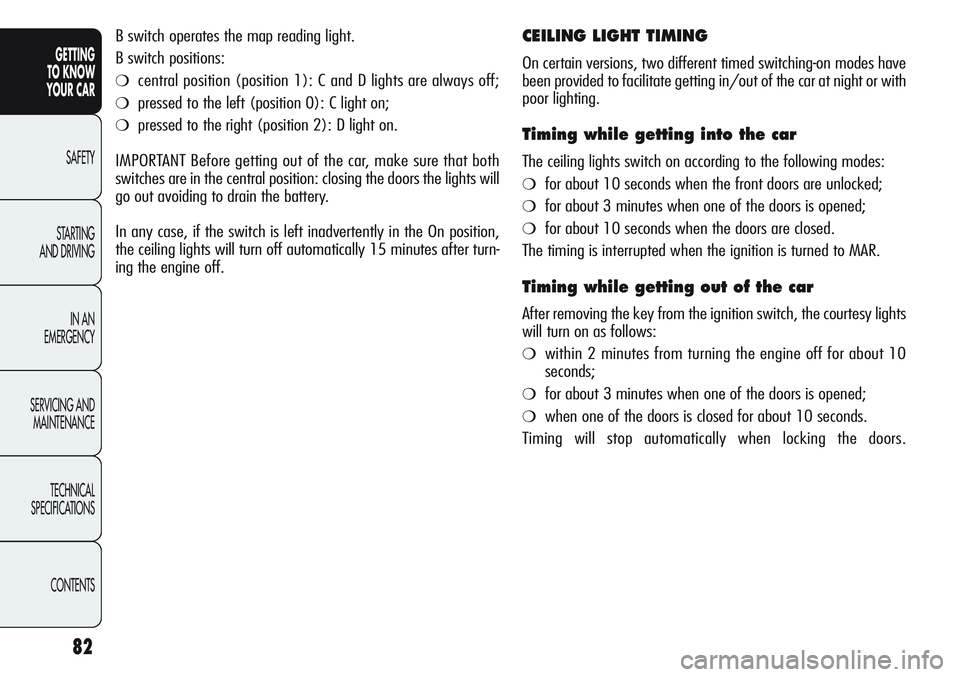
82
GETTING
TO KNOW
YOUR CAR
SAFETY
STARTING
AND DRIVING
IN AN
EMERGENCY
SERVICING AND
MAINTENANCE
TECHNICAL
SPECIFICATIONS
CONTENTS
B switch operates the map reading light.
B switch positions:
❍central position (position 1): C and D lights are always off;
❍pressed to the left (position 0): C light on;
❍pressed to the right (position 2): D light on.
IMPORTANT Before getting out of the car, make sure that both
switches are in the central position: closing the doors the lights will
go out avoiding to drain the battery.
In any case, if the switch is left inadvertently in the On position,
the ceiling lights will turn off automatically 15 minutes after turn-
ing the engine off.
CEILING LIGHT TIMING
On certain versions, two different timed switching-on modes have
been provided to facilitate getting in/out of the car at night or with
poor lighting.
Timing while getting into the car
The ceiling lights switch on according to the following modes:
❍for about 10 seconds when the front doors are unlocked;
❍for about 3 minutes when one of the doors is opened;
❍for about 10 seconds when the doors are closed.
The timing is interrupted when the ignition is turned to MAR.
Timing while getting out of the car
After removing the key from the ignition switch, the courtesy lights
will turn on as follows:
❍within 2 minutes from turning the engine off for about 10
seconds;
❍for about 3 minutes when one of the doors is opened;
❍when one of the doors is closed for about 10 seconds.
Timing will stop automatically when locking the doors.
Page 88 of 297
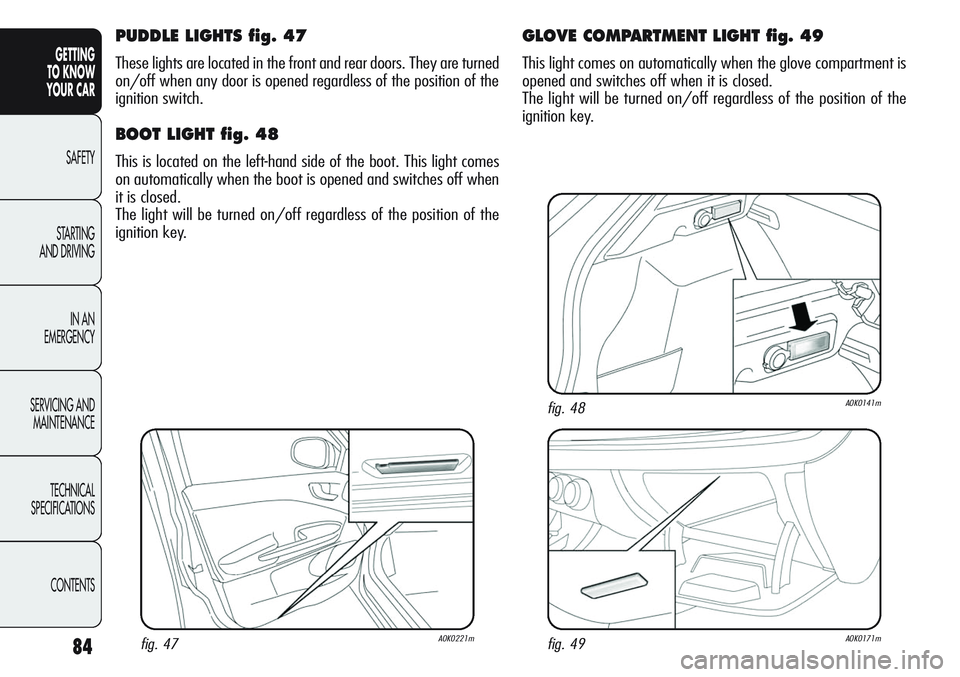
84
GETTING
TO KNOW
YOUR CAR
SAFETY
STARTING
AND DRIVING
IN AN
EMERGENCY
SERVICING AND
MAINTENANCE
TECHNICAL
SPECIFICATIONS
CONTENTS
PUDDLE LIGHTS fig. 47
These lights are located in the front and rear doors. They are turned
on/off when any door is opened regardless of the position of the
ignition switch.
BOOT LIGHT fig. 48
This is located on the left-hand side of the boot. This light comes
on automatically when the boot is opened and switches off when
it is closed.
The light will be turned on/off regardless of the position of the
ignition key.
fig. 47A0K0221m
GLOVE COMPARTMENT LIGHT fig. 49
This light comes on automatically when the glove compartment is
opened and switches off when it is closed.
The light will be turned on/off regardless of the position of the
ignition key.
fig. 49A0K0171m
fig. 48A0K0141m
Page 90 of 297
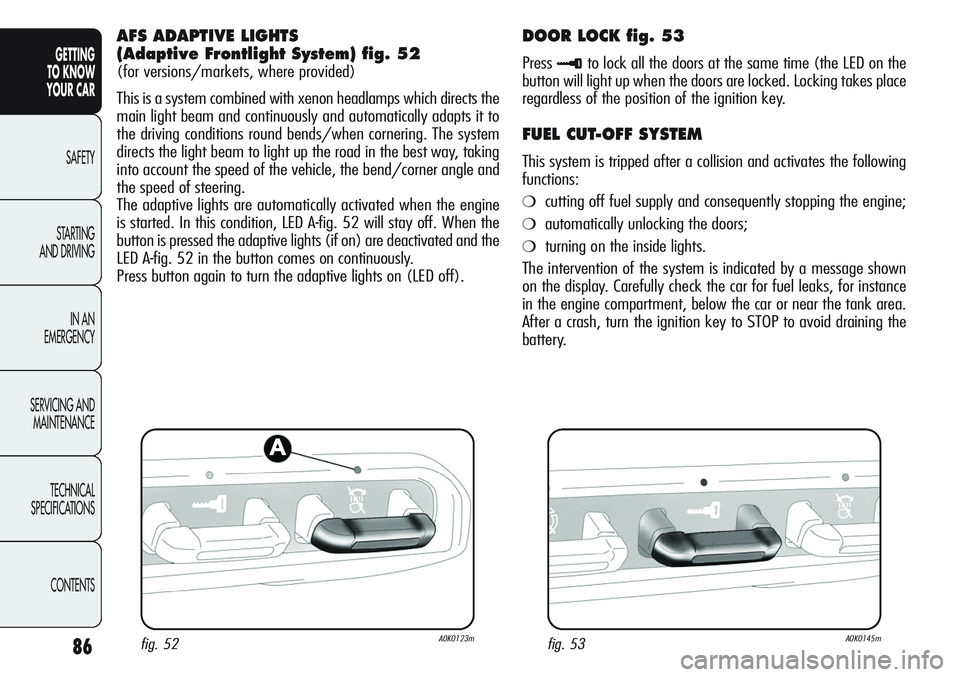
86
GETTING
TO KNOW
YOUR CAR
SAFETY
STARTING
AND DRIVING
IN AN
EMERGENCY
SERVICING AND
MAINTENANCE
TECHNICAL
SPECIFICATIONS
CONTENTS
AFS ADAPTIVE LIGHTS
(Adaptive Frontlight System) fig. 52
(for versions/markets, where provided)
This is a system combined with xenon headlamps which directs the
main light beam and continuously and automatically adapts it to
the driving conditions round bends/when cornering. The system
directs the light beam to light up the road in the best way, taking
into account the speed of the vehicle, the bend/corner angle and
the speed of steering.
The adaptive lights are automatically activated when the engine
is started. In this condition, LED A-fig. 52 will stay off. When the
button is pressed the adaptive lights (if on) are deactivated and the
LED A-fig. 52 in the button comes on continuously.
Press button again to turn the adaptive lights on (LED off).
fig. 52A0K0123m
DOOR LOCK fig. 53
Press≈to lock all the doors at the same time (the LED on the
button will light up when the doors are locked. Locking takes place
regardless of the position of the ignition key.
FUEL CUT-OFF SYSTEM
This system is tripped after a collision and activates the following
functions:
❍cutting off fuel supply and consequently stopping the engine;
❍automatically unlocking the doors;
❍turning on the inside lights.
The intervention of the system is indicated by a message shown
on the display. Carefully check the car for fuel leaks, for instance
in the engine compartment, below the car or near the tank area.
After a crash, turn the ignition key to STOP to avoid draining the
battery.
fig. 53A0K0145m
Page 91 of 297

87
GETTING
TO KNOW
YOUR CAR
SAFETY
STARTING
AND DRIVING
IN AN
EMERGENCY
SERVICING AND
MAINTENANCE
TECHNICAL
SPECIFICATIONS
CONTENTS
Follow the procedure below to restore correct operation of the
car:
❍turn the ignition key to MAR;
❍activate the right-hand direction indicator;
❍deactivate the right-hand direction indicator;
❍activate the left-hand direction indicator;
❍deactivate the left-hand direction indicator;
❍activate the right-hand direction indicator;
❍deactivate the right-hand direction indicator;
❍activate the left-hand direction indicator;
❍deactivate the left-hand direction indicator;
❍turn the ignition key to STOP.
If, after a collision, you smell fuel or notice leaks from
the fuel system, do not reset the system to avoid fire
risk.
INTERIOR FITTINGS
GLOVE COMPARTMENT
Upper compartment
Operate in the point shown by the arrow to open the compartment
A-fig. 54.
Passenger side glove compartment
Operate A handle fig. 55 to open the compartment. When the com-
partment is opened a courtesy light comes on.
There is a map pocket in the compartment and a sunglass holder
on the back of the hatch.
fig. 54A0K0142mfig. 55A0K0100m
Page 94 of 297
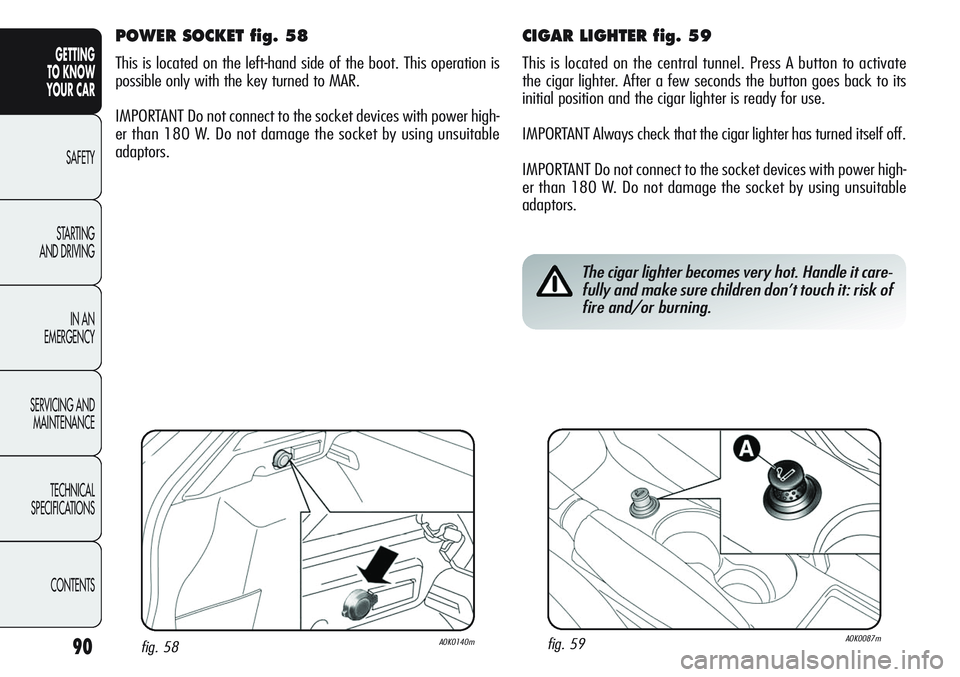
90
GETTING
TO KNOW
YOUR CAR
SAFETY
STARTING
AND DRIVING
IN AN
EMERGENCY
SERVICING AND
MAINTENANCE
TECHNICAL
SPECIFICATIONS
CONTENTS
CIGAR LIGHTER fig. 59
This is located on the central tunnel. Press A button to activate
the cigar lighter. After a few seconds the button goes back to its
initial position and the cigar lighter is ready for use.
IMPORTANT Always check that the cigar lighter has turned itself off.
IMPORTANT Do not connect to the socket devices with power high-
er than 180 W. Do not damage the socket by using unsuitable
adaptors.
The cigar lighter becomes very hot. Handle it care-
fully and make sure children don’t touch it: risk of
fire and/or burning.
fig. 59A0K0087m
POWER SOCKET fig. 58
This is located on the left-hand side of the boot. This operation is
possible only with the key turned to MAR.
IMPORTANT Do not connect to the socket devices with power high-
er than 180 W. Do not damage the socket by using unsuitable
adaptors.
fig. 58A0K0140m
Page 96 of 297
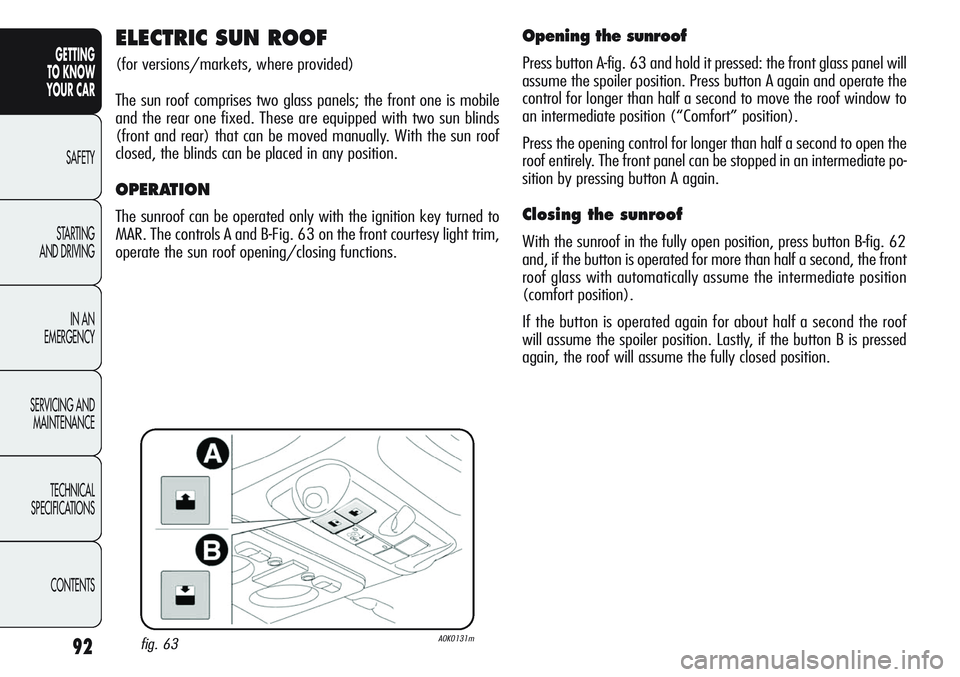
92
GETTING
TO KNOW
YOUR CAR
SAFETY
STARTING
AND DRIVING
IN AN
EMERGENCY
SERVICING AND
MAINTENANCE
TECHNICAL
SPECIFICATIONS
CONTENTS
ELECTRIC SUN ROOF
(for versions/markets, where provided)
The sun roof comprises two glass panels; the front one is mobile
and the rear one fixed. These are equipped with two sun blinds
(front and rear) that can be moved manually. With the sun roof
closed, the blinds can be placed in any position.
OPERATION
The sunroof can be operated only with the ignition key turned to
MAR. The controls A and B-Fig. 63 on the front courtesy light trim,
operate the sun roof opening/closing functions.
Opening the sunroof
Press button A-fig. 63 and hold it pressed: the front glass panel will
assume the spoiler position. Press button A again and operate the
control for longer than half a second to move the roof window to
an intermediate position (“Comfort” position).
Press the opening control for longer than half a second to open the
roof entirely. The front panel can be stopped in an intermediate po-
sition by pressing button A again.
Closing the sunroof
With the sunroof in the fully open position, press button B-fig. 62
and, if the button is operated for more than half a second, the front
roof glass with automatically assume the intermediate position
(comfort position).
If the button is operated again for about half a second the roof
will assume the spoiler position. Lastly, if the button B is pressed
again, the roof will assume the fully closed position.
fig. 63A0K0131m
Page 97 of 297
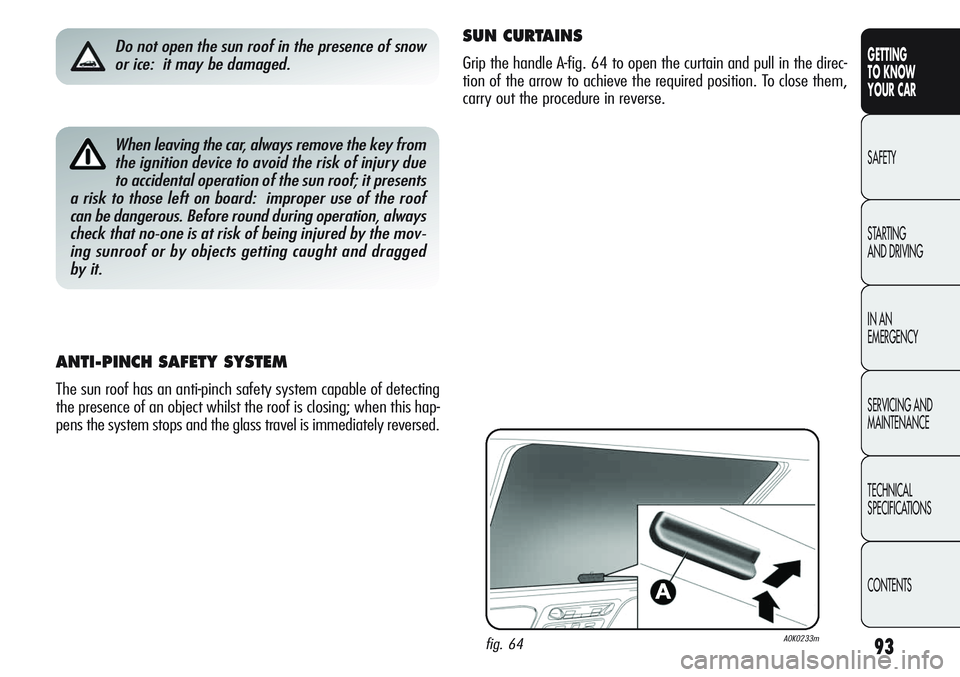
93
GETTING
TO KNOW
YOUR CAR
SAFETY
STARTING
AND DRIVING
IN AN
EMERGENCY
SERVICING AND
MAINTENANCE
TECHNICAL
SPECIFICATIONS
CONTENTSWhen leaving the car, always remove the key from
the ignition device to avoid the risk of injury due
to accidental operation of the sun roof; it presents
a risk to those left on board: improper use of the roof
can be dangerous. Before round during operation, always
check that no-one is at risk of being injured by the mov-
ing sunroof or by objects getting caught and dragged
by it.
Do not open the sun roof in the presence of snow
or ice: it may be damaged.
fig. 64A0K0233m
SUN CURTAINS
Grip the handle A-fig. 64 to open the curtain and pull in the direc-
tion of the arrow to achieve the required position. To close them,
carry out the procedure in reverse.
ANTI-PINCH SAFETY SYSTEM
The sun roof has an anti-pinch safety system capable of detecting
the presence of an object whilst the roof is closing; when this hap-
pens the system stops and the glass travel is immediately reversed.
Page 98 of 297
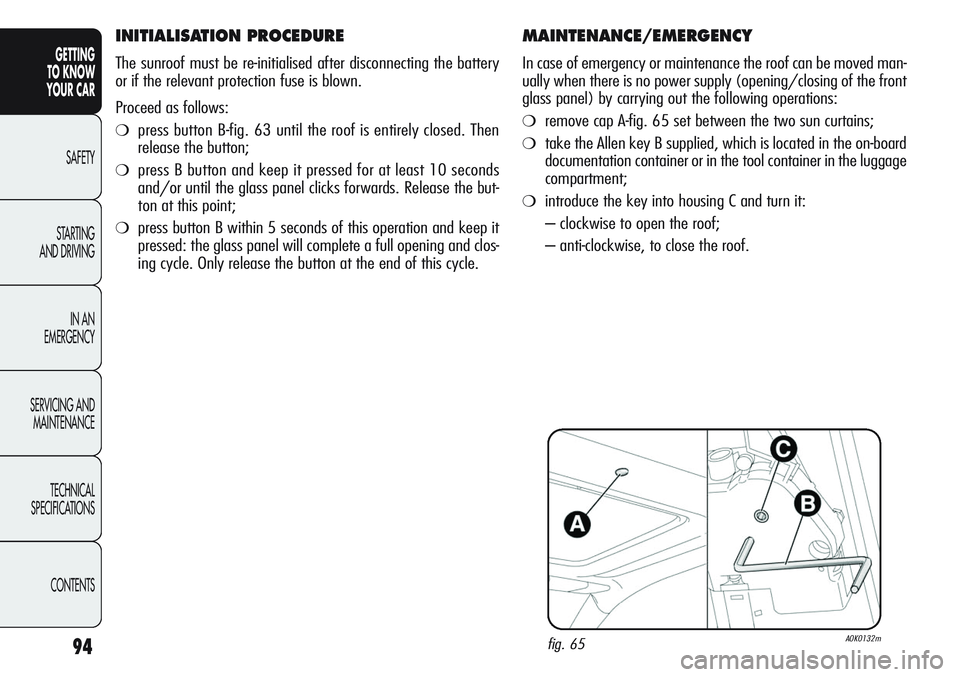
94
GETTING
TO KNOW
YOUR CAR
SAFETY
STARTING
AND DRIVING
IN AN
EMERGENCY
SERVICING AND
MAINTENANCE
TECHNICAL
SPECIFICATIONS
CONTENTS
MAINTENANCE/EMERGENCY
In case of emergency or maintenance the roof can be moved man-
ually when there is no power supply (opening/closing of the front
glass panel) by carrying out the following operations:
❍remove cap A-fig. 65 set between the two sun curtains;
❍take the Allen key B supplied, which is located in the on-board
documentation container or in the tool container in the luggage
compartment;
❍introduce the key into housing C and turn it:
– clockwise to open the roof;
– anti-clockwise, to close the roof.
fig. 65A0K0132m
INITIALISATION PROCEDURE
The sunroof must be re-initialised after disconnecting the battery
or if the relevant protection fuse is blown.
Proceed as follows:
❍press button B-fig. 63 until the roof is entirely closed. Then
release the button;
❍press B button and keep it pressed for at least 10 seconds
and/or until the glass panel clicks forwards. Release the but-
ton at this point;
❍press button B within 5 seconds of this operation and keep it
pressed: the glass panel will complete a full opening and clos-
ing cycle. Only release the button at the end of this cycle.
Page 99 of 297
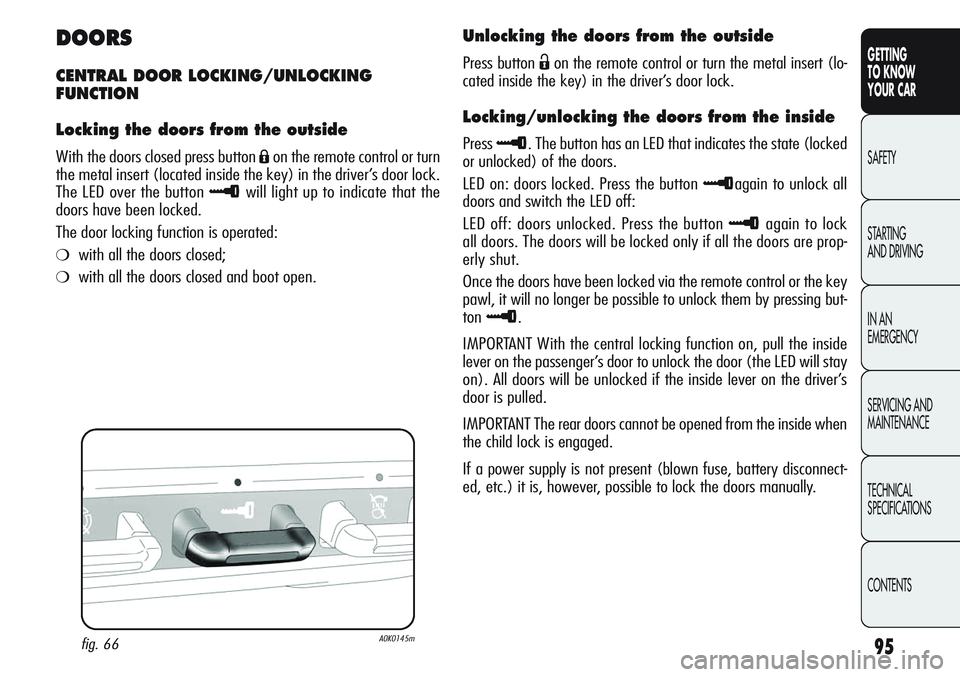
95
GETTING
TO KNOW
YOUR CAR
SAFETY
STARTING
AND DRIVING
IN AN
EMERGENCY
SERVICING AND
MAINTENANCE
TECHNICAL
SPECIFICATIONS
CONTENTS
DOORS
CENTRAL DOOR LOCKING/UNLOCKING
FUNCTION
Locking the doors from the outside
With the doors closed press button Áon the remote control or turn
the metal insert (located inside the key) in the driver’s door lock.
The LED over the button
≈will light up to indicate that the
doors have been locked.
The door locking function is operated:
❍with all the doors closed;
❍with all the doors closed and boot open.
fig. 66A0K0145m
Unlocking the doors from the outside
Press button Ëon the remote control or turn the metal insert (lo-
cated inside the key) in the driver’s door lock.
Locking/unlocking the doors from the inside
Press≈. The button has an LED that indicates the state (locked
or unlocked) of the doors.
LED on: doors locked. Press the button
≈again to unlock all
doors and switch the LED off:
LED off: doors unlocked. Press the button
≈again to lock
all doors. The doors will be locked only if all the doors are prop-
erly shut.
Once the doors have been locked via the remote control or the key
pawl, it will no longer be possible to unlock them by pressing but-
ton
≈.
IMPORTANT With the central locking function on, pull the inside
lever on the passenger’s door to unlock the door (the LED will stay
on). All doors will be unlocked if the inside lever on the driver’s
door is pulled.
IMPORTANT The rear doors cannot be opened from the inside when
the child lock is engaged.
If a power supply is not present (blown fuse, battery disconnect-
ed, etc.) it is, however, possible to lock the doors manually.